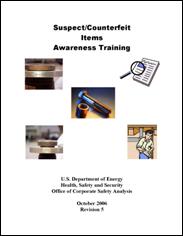Suspect/Counterfeit Items Awareness Training
 During the last 20 years, the industry has become aware of a massive influx of counterfeit bolts in the American market. Counterfeiting is a problem present not only in fasteners, but also in numerous other nuclear and non- nuclear components as well. The automobile industry has witnessed similar problems with bogus parts, and the aviation industry is struggling with an increasing influx of unapproved parts and assemblies.
During the last 20 years, the industry has become aware of a massive influx of counterfeit bolts in the American market. Counterfeiting is a problem present not only in fasteners, but also in numerous other nuclear and non- nuclear components as well. The automobile industry has witnessed similar problems with bogus parts, and the aviation industry is struggling with an increasing influx of unapproved parts and assemblies.
Some manufacturers and suppliers use inferior materials and processes to manufacture substandard items whose properties can significantly vary from established standards and specifications. Substandard materials known as suspect/counterfeit items (S/CI) pose immediate and potential threats to the safety of DOE and contractor workers, the public and the environment. Failure of a safety system due to an S/CI could also have security implication at the DOE facilities.
In most cases, fraud is the cause of the problem. Companies or persons, who misrepresent material, provide materials that do not meet consensus standards, or alter markings to make materials appear to meet consensus standards are in fact defrauding the government, industry and the public. Unfortunately, this problem continues to increase despite measures to detect and eliminate counterfeit, bogus, or unapproved items. In 1994, counterfeiting was estimated to be a $20 billion business in the United States. By 2000, it had expanded to a $200 billion business ($1 trillion globally).
Identified counterfeit, bogus, or unapproved materials (and any other term an industry may use for these items) include electrical breakers and switches, bolts, tube steel, flanges, lifting slings, and brake pads and linings. Commercial nuclear and private industries, as well as government and public, are not safe from these parts and materials. Their presence is pervasive and the consequences are real; tragedies have occurred as the result of materials that did not meet required design specifications.
Surveys and studies have been performed by various industries in an attempt to understand this problem. The reports clearly identify the current problems and generally recommend that training programs be developed to allow procurement, engineering, operations, maintenance, and inspection personnel to identify and eliminate substandard parts and materials. The reports recognize the removal of these parts and materials as only the first step in the process. A system of prevention, established when all organizations are fully aware of the issues, must be implemented from the top down. Line management must understand and endorse preventive measures. Only when the designer (who specifies and item), the buyer (who procures the item), the receiving inspector (who examines the item), the end user (who installs and operates the item), and the supplier (who supplies the item) work together to control this problem will we begin to see positive results. This requires all parties to communicate with each other to identify and resolve problems.
This problem is not new; counterfeiting, copyright and trademark infringements, and out-and-out fraud have been occurring in this country since regulations were first established. Unfortunately, a high percentage of these activities originate form foreign sources, sometimes to the knowledge of U.S. importers. Allowing these unscrupulous business activities to take place is unacceptable. Detection of counterfeit, bogus, or unapproved products is possible, but identifying these items is every ones responsibility with the assistance of qualified personnel to aid in making the final determination.
Examples of locations in which installed S/CI have been discovered include:
- Cranes, elevators, and fork lifts: critical load paths;
- Vehicles: engines, brakes, or steering mechanisms;
- Aircraft: engines and attachments, wings, tails, and landing gear;
- Facilities: valves, compressors, and vessels used to contain radioactive fluids, high temperature or high-pressure steam or fluids, or other hazardous material or safety systems supporting safe operation or shutdown of a facility or process.
Click here to download the entire Suspect/Counterfeit Items Awareness Training Booklet provided by the U.S. Dept. of Energy Health, Safety and Security Office of Corporate Safety Analysis.